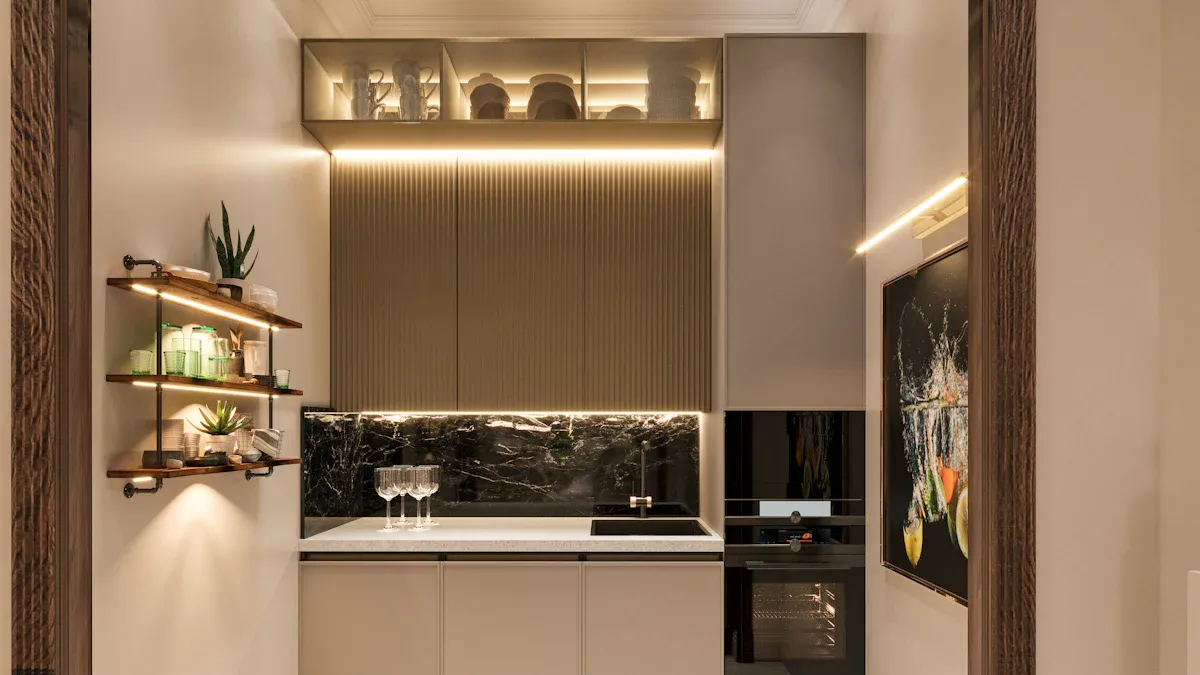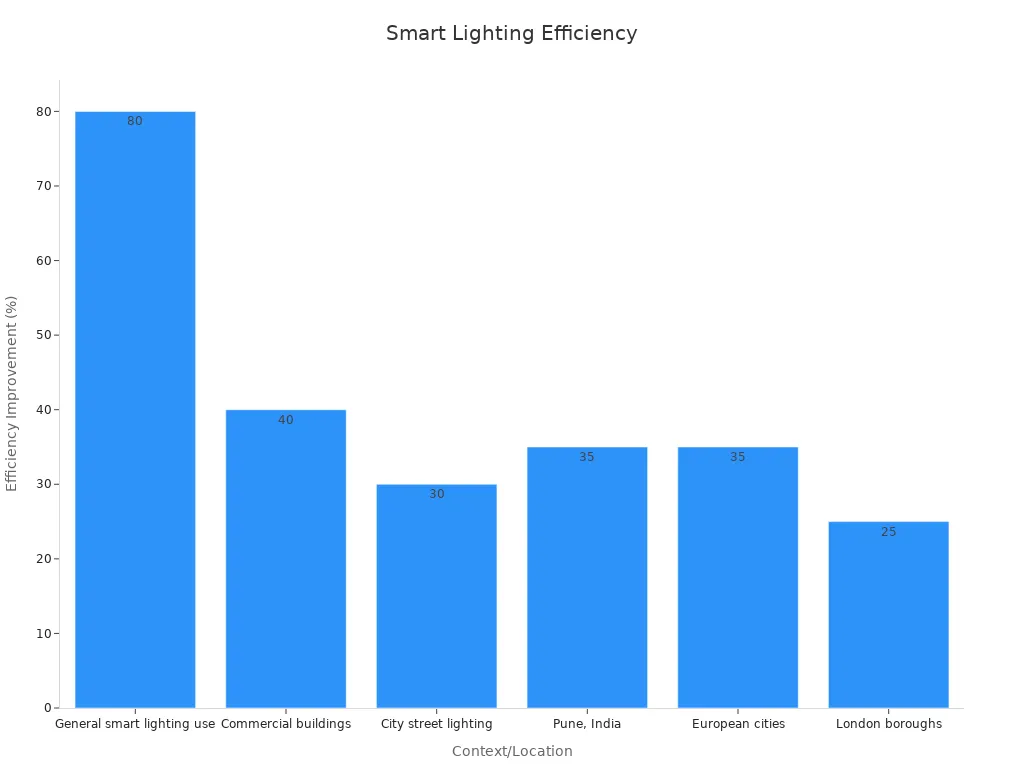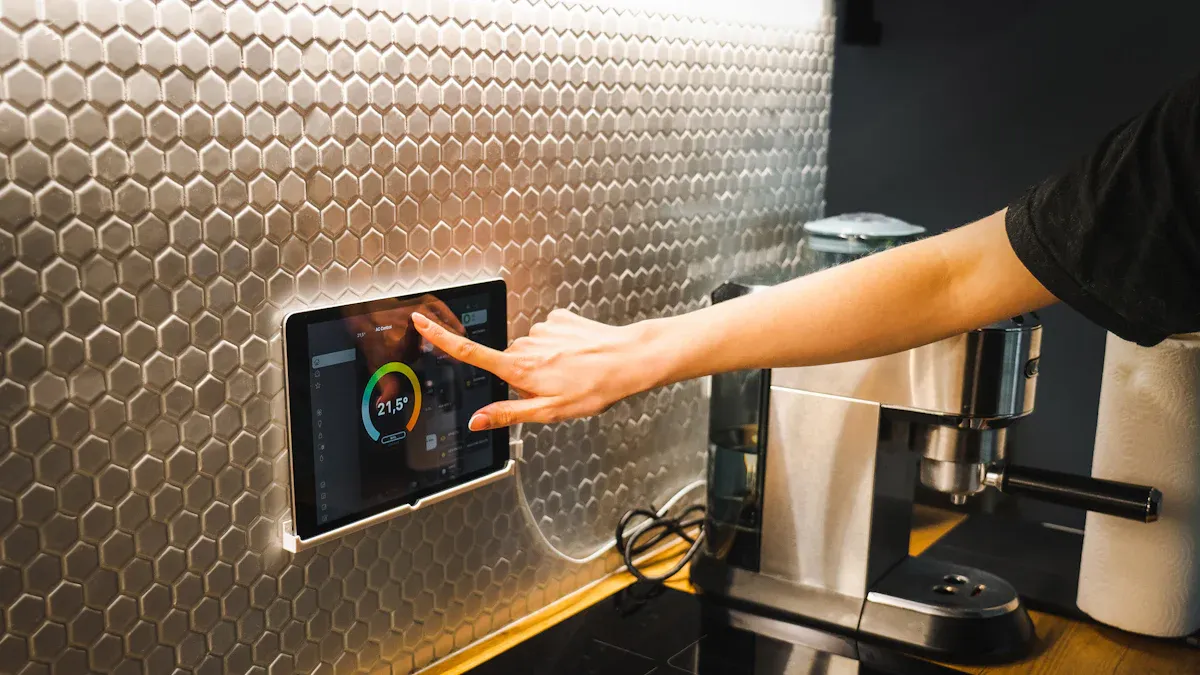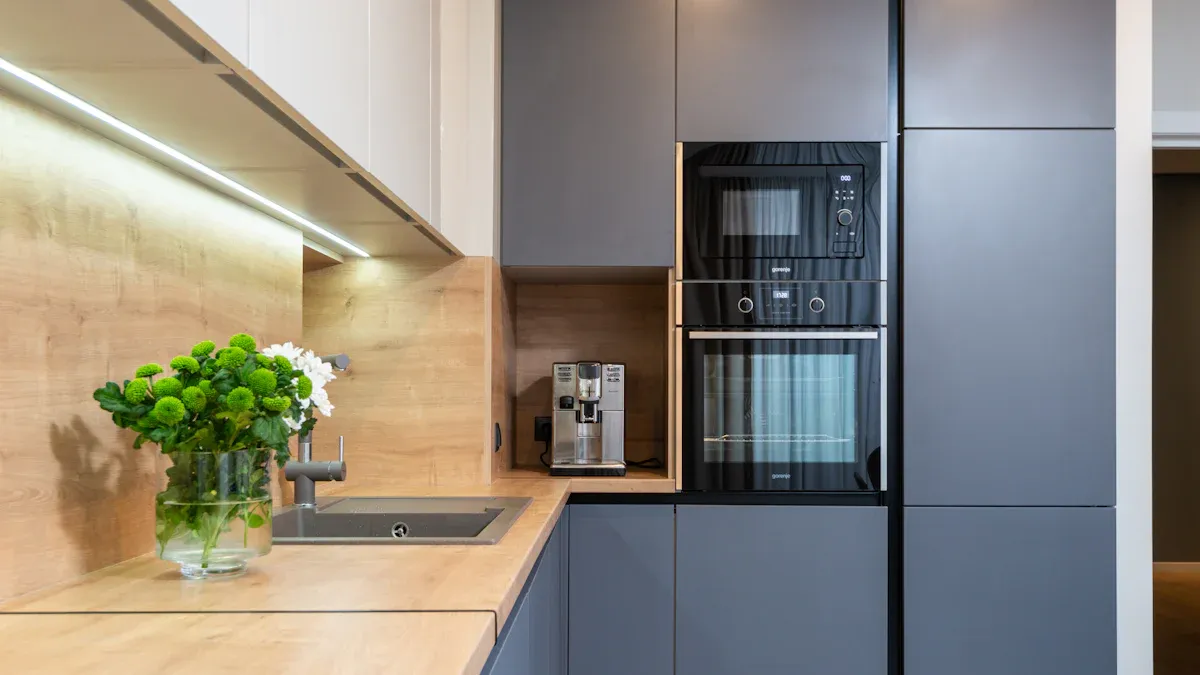
When I think about making my kitchen smarter, I always start with lighting. Smart under cabinet light options have changed how I cook, clean, and relax. These lights let me control brightness and color with just a tap or a voice command. They save energy too—some smart lighting setups can cut energy use by up to 80%.

I love how these lights blend style and function, making my kitchen feel modern and inviting.
Key Takeaways
- Smart under cabinet lights offer adjustable brightness, color options, and voice control to make your kitchen more convenient and stylish.
- These lights save energy by using efficient LEDs and smart features like scheduling and motion sensors, helping lower your electricity bills.
- Choosing the right type and planning installation carefully ensures your kitchen lighting fits your style and needs while avoiding common setup problems.
What Is a Smart Under Cabinet Light?

Key Features
When I first explored smart under cabinet lights, I noticed how many cool features they offer. These lights do more than just brighten up my countertops. Here are some things I love:
- Adjustable brightness: I can dim the lights for a cozy dinner or turn them up when I need to see every detail while chopping veggies.
- Color options: Some models let me pick from warm white to cool daylight, or even fun colors for parties.
- Voice control: I use my smart speaker to turn the lights on or off without touching a switch.
- Scheduling and automation: I set my lights to turn on at sunset or when I walk into the kitchen.
- Energy efficiency: Many smart under cabinet light options use LEDs, which help me save on my electricity bill.
Tip: If you want a modern kitchen that feels high-tech, look for lights that connect with your existing smart home system.
Why It Matters
Smart under cabinet lights make a real difference in my daily routine. I save time because I can control everything with my phone or voice. My kitchen feels safer, especially at night, since I never have to fumble for a switch.
I’ve also noticed that more people are choosing these lights. In places like Japan and India, the market for smart kitchen appliances is growing fast. People want kitchens that are stylish, efficient, and easy to use. As more homes get connected, smart under cabinet lights are becoming a must-have for anyone who loves cooking or entertaining. The rise of e-commerce makes it even easier to find the perfect light for any kitchen style.
Benefits of Under Cabinet Light Solutions
Convenience & Control
I love how smart lighting puts me in charge of my kitchen. With just a tap on my phone or a quick voice command, I can set the perfect mood for cooking or relaxing. I don’t have to walk across the room to flip a switch. I can even schedule my lights to turn on before I get home. Surveys show that most people feel the same way—7 out of 10 buyers want smart homes, and 78% are willing to pay more for features like smart lighting. I’ve noticed that when I have guests over, they always comment on how easy it is to control the lights. It makes my kitchen feel modern and welcoming.
Did you know? Hotels that offer smart lighting controls see more guests return, just because of the added convenience.
Energy Savings
Saving energy matters to me, and smart under cabinet lights help a lot. These lights use LEDs, which are super efficient. I track my energy use and see real savings each month. Here’s what makes the difference:
- Smart controls like dimming and scheduling cut down on wasted energy.
- LED fixtures can reduce energy use by up to 30% compared to older lights.
- Features like occupancy sensors turn lights off when I leave the room.
I also learned that experts use special tools to measure energy savings, like energy use intensity and peak demand reduction. These numbers prove that smart lighting really works.
Design Flexibility
Every kitchen is different, and I want mine to match my style. Smart under cabinet lights fit right in, whether I go for a modern, farmhouse, or industrial look. I can pick from warm or cool colors, and even change the brightness to match the time of day. Designers say that layered lighting—mixing task, ambient, and accent lights—makes kitchens more comfortable and flexible. The market for dimmable lighting is growing fast, which shows that people want options. I love being able to adjust my lights for cooking, cleaning, or just hanging out with friends.
How Smart Under Cabinet Lights Work
Connectivity Options
When I set up my first smart under cabinet light, I noticed how many ways I could connect it. Most models use Wi-Fi or Bluetooth. Some even work with a smart hub. Here’s what I found:
- Wi-Fi lets me control my lights from anywhere, as long as I have internet.
- Bluetooth works well for quick, local control when I’m nearby.
- Smart hubs, like Zigbee or Z-Wave, help connect several devices together.
These lights have tiny processors and wireless receivers inside. That’s how they talk to my phone or smart home system. I learned that the closer my lights are to my router or hub, the better the connection.
Control Methods
I love having options for how I control my kitchen lighting. I use a smartphone app to adjust brightness or change colors. Sometimes, I just ask my voice assistant to turn the lights on. Many lights also have motion sensors. When I walk into the kitchen, the lights turn on automatically. The sensors use passive infrared technology, which means they can sense movement within a certain range and angle.
Tip: If your lights don’t respond, check your wireless connection or move the sensor to a better spot.
Smart Home Integration
My favorite part is how easily these lights fit into my smart home. I connect them with Alexa, Google Home, or Apple Home. This lets me create scenes, like “Cooking Time” or “Movie Night,” where the lights change to match the mood. I can schedule them to turn on at sunset or dim when it’s time to relax. With all these features, my under cabinet light setup feels like a true part of my connected home.
Types of Under Cabinet Light Options
When I started looking for the best way to light up my kitchen, I realized there are so many types of under cabinet lights. Each one has its own style, features, and benefits. Let me walk you through the main options I considered and what I learned about each.
LED Strips
LED strips are one of my favorite choices for a modern kitchen. They come as long, flexible ribbons with tiny LEDs packed close together. I love how easy it is to tuck them under cabinets for a seamless look. These strips are super slim, so they stay hidden but give off plenty of light.
Here’s a quick look at the specs I checked before buying:
| Specification Type | Benchmark / Description |
|---|---|
| Brightness | Lumens (measure of light output) |
| Power Consumption | Wattage |
| Color Temperature (CCT) | Typically 3000K to 5000K for kitchen lighting |
| Color Rendering Index (CRI) | Indicates color accuracy and quality |
| Safety Ratings | UL Listed, Wet Location Rated |
| Compliance Standards | Title 24 and Title 20 Compliant |
| Enclosed Rating | Suitable for enclosed fixtures |
| Warranty | Typically 5 years |
I noticed that LED strips offer great energy efficiency and last a long time. I can pick the brightness and color temperature that fits my kitchen. Most strips are dimmable, so I can set the mood for any occasion. The low-profile design means I don’t have to worry about bulky fixtures getting in the way.
Tip: If you want a clean, modern look, LED strips are hard to beat. They work well for both task and accent lighting.
Puck Lights
Puck lights are small, round fixtures that remind me of hockey pucks. I like using them to create pools of light under cabinets. They work great for highlighting certain spots, like a coffee station or a cutting board. I can space them out for even coverage or group them for a dramatic effect.
Puck lights often come in packs, and I can choose between hardwired, plug-in, or battery-powered models. Some have motion sensors, which I find handy when my hands are full. The main downside is that they can create shadows if I don’t space them right. Still, they add a nice touch of style and focus.
Light Bars
Light bars are long, rigid fixtures that give off a smooth, even light. I like how they fit under most cabinets and provide strong illumination for cooking and cleaning. Many light bars have built-in diffusers, so the light spreads out without harsh spots.
I’ve seen both plug-in and hardwired versions. Some models let me link several bars together for a custom fit. Light bars are a solid choice if I want bright, shadow-free lighting for my whole countertop. They also come in slim designs, so they don’t stick out or clash with my kitchen decor.
Hardwired vs. Plug-In
When I picked out my under cabinet light, I had to decide between hardwired and plug-in options. Hardwired lights connect directly to my home’s electrical system. They look neat and professional, with no visible cords. The downside? Installation can get tricky and might need an electrician.
Plug-in lights are much easier to set up. I just plug them into a nearby outlet and I’m good to go. Some plug-in models come with remote controls or smart features, which I find super convenient. The only thing I don’t like is seeing the cords, but I can usually hide them with a little planning.
Note: Hardwired lights are great for permanent setups, while plug-in options give me more flexibility if I want to move things around later.
Battery & Wireless
Battery-powered and wireless lights have become really popular in the last few years. I love these for spots where I don’t have an outlet nearby. Many models use rechargeable batteries, so I don’t have to keep buying replacements. Some even have motion sensors, which turn the lights on when I walk into the kitchen.
Manufacturers test these lights for durability and performance. Here’s what they check:
- Thermal Test: Makes sure the light works well at different temperatures.
- Vibration Test: Checks if the light can handle bumps and movement.
- Rain Test: Tests resistance to water and moisture, which is great if I use them near the sink.
Most battery-powered lights use lithium-ion batteries. These last a long time and hold a lot of energy, so I don’t have to recharge them often. Wireless lights are perfect for renters or anyone who wants a quick, no-fuss upgrade.
Callout: If you want the easiest installation, go with battery or wireless lights. Just stick them on, and you’re done!
Comparing the Options
Here’s how I see the pros and cons for each type in the kitchen:
| Type | Pros | Cons |
|---|---|---|
| LED Strips | Sleek, energy-efficient, flexible layout | Needs careful measuring and placement |
| Puck Lights | Focused light, easy to install | Can create shadows if spaced poorly |
| Light Bars | Even light, great for tasks | May need multiple bars for big areas |
| Hardwired | Clean look, permanent solution | Complex installation |
| Plug-In | Easy setup, portable | Visible cords |
| Battery/Wireless | No wiring, flexible, quick install | Needs recharging or battery changes |
I always recommend thinking about your kitchen’s layout, how much light you need, and how much effort you want to put into installation. Each type of under cabinet light brings something special to the table. I found that mixing and matching can give me the best of all worlds.
Choosing the Right Under Cabinet Light
Brightness & Color
When I pick lighting for my kitchen, I always check the brightness first. I want enough light to see what I’m doing, but not so much that it feels harsh. Most smart lights let me adjust the brightness, which helps a lot. I also like to play with color temperature. Warm white makes my kitchen feel cozy, while cool white gives a clean, modern look. Some lights even let me pick fun colors for parties or holidays.
Installation & Layout
I look at my kitchen layout before I buy anything. I measure the space under my cabinets and think about where I need the most light. I find that LED strips work well for long counters, while puck lights are great for small spots. I always check if I need to drill holes or if I can just stick the lights on. Planning ahead saves me a lot of trouble during installation.
Tip: Lay out your lights before you install them. This way, you can see how the light spreads and avoid dark spots.
Control & Compatibility
I love using my phone or voice to control my kitchen lights. Before I buy, I make sure the lights work with my smart home system. Some lights connect with Alexa, Google Home, or Apple HomeKit. I also look for features like motion sensors or remote controls. These options make my kitchen feel high-tech and easy to use.
Design Match
Matching my lights to my kitchen style matters to me. I’ve seen some amazing kitchens where lighting brings everything together:
- A kitchen with vintage Peranakan tiles and under cabinet lighting blends old charm with modern finishes.
- A bright, mostly white kitchen uses warm under-cabinet lighting to create an airy, inviting space.
- A renovated flat with tempered glass and sleek lighting shows how smart lights fit a minimal, modern look.
These examples inspire me to choose lights that fit my own style and make my kitchen shine.
Installation & Setup

Step-by-Step Guide
When I installed my smart lights, I followed a simple process that made everything easier. First, I measured the space under my cabinets. I wanted to make sure the lights would fit perfectly. For light strips, I cut them at the marked points so they matched my cabinet length. I used connectors to join pieces through small holes in the cabinet sides. Then, I mounted the strips inside aluminum channels with diffuser covers. This gave my kitchen a clean, finished look and helped spread the light evenly.
After mounting, I plugged in the lights and connected them to my smart home app. I tested each section to make sure everything worked. If I used puck lights, I spaced them about 10 inches apart for even lighting. I picked the right brightness and color temperature for my kitchen. I always test and adjust the lights before finishing up.
Tip: Adjust the placement of your lights to avoid harsh lines on the ceiling or visible LED spots on the wall. This helps create a soft, even glow on your countertops.
Common Pitfalls
I ran into a few problems during my first install. Sometimes, I placed the lights too close to the wall, which made bright spots show up. I learned to move them forward for better coverage. I also forgot to check my power connections once, and the lights didn’t turn on. Now, I always double-check the wiring and connections before finishing.
Here are some common mistakes to watch out for:
- Placing lights unevenly, which causes shadows or dark spots.
- Forgetting to clean the surface before sticking on lights, so they fall off later.
- Not testing the lights before final installation.
- Overlooking battery life for wireless models—always keep spares handy!
Note: Regularly clean your lights with a soft cloth and check batteries if you use wireless models. This keeps everything working smoothly.
Troubleshooting & Maintenance
Common Issues
Sometimes, my smart kitchen lights act up. I have seen a few problems pop up more than once. Here are the most common ones I run into:
- Lights not turning on: I check the power source first. Sometimes, a loose plug or dead battery causes this.
- Connectivity problems: My lights lose connection with Wi-Fi or Bluetooth. I restart my router or move the hub closer.
- Unresponsive controls: The app or voice commands stop working. I update the app or reset the device.
- Flickering or dimming: This usually means a loose connection or a low battery. I tighten the wires or recharge the battery.
Tip: If your lights keep disconnecting, try reducing the number of devices on your Wi-Fi network.
Care Tips
I want my kitchen lights to last as long as possible. Here’s what I do to keep them in top shape:
- I wipe the lights with a soft, dry cloth every week. This keeps dust and grease away.
- I check the batteries in my wireless models once a month. Fresh batteries mean bright lights.
- I inspect the mounting strips and connectors. If anything feels loose, I fix it right away.
- I update the smart app when new versions come out. This helps prevent bugs and keeps features working.
| Task | How Often | Why It Matters |
|---|---|---|
| Clean lights | Weekly | Keeps light bright |
| Check batteries | Monthly | Prevents dimming |
| Inspect mounting | Monthly | Avoids falling lights |
| Update app/firmware | As needed | Fixes bugs, adds features |
Note: Regular care saves money and keeps your kitchen looking great.
I see smart under cabinet light solutions as a game changer in my kitchen. They give me better lighting, save energy, and add style.
- I plan my upgrades for both function and design.
Ready to try a smart under cabinet light? Explore your options today!
FAQ
How long do smart under cabinet lights usually last?
Most of my LED smart lights last over 25,000 hours. I rarely need to replace them. That means years of bright, reliable lighting in my kitchen.
Can I install smart under cabinet lights myself?
Yes, I installed mine without hiring anyone. Most kits come with clear instructions. I just needed basic tools and a little patience.
Do smart under cabinet lights work with all smart home systems?
I always check compatibility before buying. Many lights work with Alexa, Google Home, or Apple HomeKit. Some brands only support certain systems, so I double-check first.
Post time: Jun-27-2025






